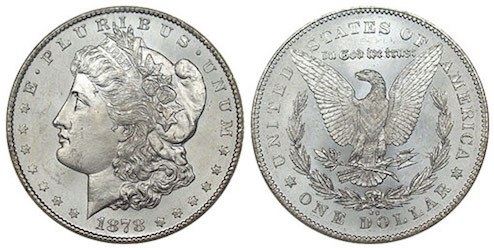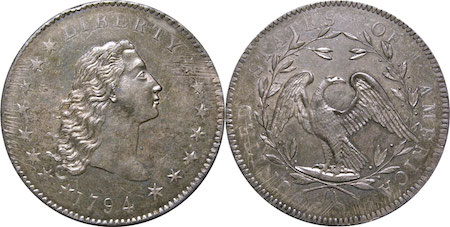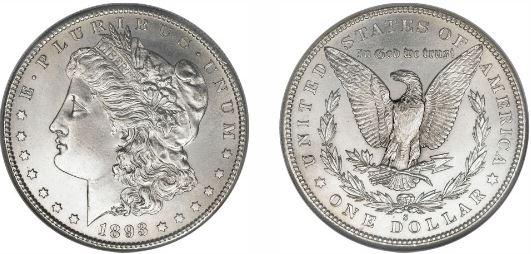
Many collectors and investors accumulate Morgan silver dollars. The Morgan Dollar is probably the world's most recognizable and collectable coin. It wasn't always that way. For a century, most morgan dollars sat ignored in storage with the public having little interest in them.
Silver Dollars -- never popular in the US
 The silver dollar was never a popular coin in the United States. The first silver dollar was minted in 1794, but production ceased by 1804. The main complaint about the dollar was that it was too heavy to carry around a pocketful of them. This was the same complaint that plagued the silver dollar for over 200 years. The silver dollar was again minted between 1840 and 1873, but the quantities were limited. Silver dollars had to compete with the smaller gold dollars and paper money, which was backed by gold. In 1873, Ulysses Grant signed a bill making gold the standard for money.
The silver dollar was never a popular coin in the United States. The first silver dollar was minted in 1794, but production ceased by 1804. The main complaint about the dollar was that it was too heavy to carry around a pocketful of them. This was the same complaint that plagued the silver dollar for over 200 years. The silver dollar was again minted between 1840 and 1873, but the quantities were limited. Silver dollars had to compete with the smaller gold dollars and paper money, which was backed by gold. In 1873, Ulysses Grant signed a bill making gold the standard for money.
The Great Depression of the 1870's
By 1873, the country was in a depression, which would continue for several years. Suddenly there was massive unemployment. Wages were cuts. Railway workers, who had been earning $1.75 per twelve hour day went on strike. Over 100,000 people went on strike by 1877.
The Bland-Allison Act and the minting of lots and lots of dollars
In 1878, Congress passed the Bland-Allison act. The act required the government to purchase between two and four million dollars worth of silver each month and convert it into silver dollars. The idea was to help the silver mining towns in the west, which, in turn, would help the midwest. The bill was vetoed by President Rutherford B. Hayes, but the veto was overridden.
In 1878, mints in Philadelphia, Carson City, and San Francisco started minting the silver dollars in large numbers. The dollars were referred to as “Bland dollars.” They were designed by George Morgan, but were not called Morgan dollars until after his death. Over twenty million dollars were produced in 1878 alone. This was more than the total number of silver dollars produced going all the way back to 1794.
There was, of course, no use for all of these dollars. While a few circulated, the treasury had the job of storing the majority, many of which were not released until the 1960’s.
Because most of the dollars were stored, many survived in the highest of grades. For some of the early dates, it is estimated that millions survive today in the mint state.
1893

Millions of Morgans were produced per year until 1893. 1893 began as normal with In January, Philadelphia minted 200,000; New Orleans minted 300,000; Carson City minted 130,000; and San Francisco minted 100,000. Then the US suffered its worst economic collapse in history. Over 600 banks failed and 16,000 businesses closed. Twenty percent of all workers were unemployed. For those who had work, wages were low and working conditions were harsh. In 1893,the American Railway Union formed. Fourteen thousand police and troops were used in Chicago to break up a strike.

During 1893, Carson City continued minting dollars until May. That was to be the final dollar ever produced at Carson City. Many of these 1893CC’s stayed in the treasury and were eventually released by Richard Nixon in 1970. They were sold to the public for $40. Philadelphia minted dollars in February, and a small number in April. For New Orleans and San Francisco, no additional dollars were produced in 1893 after January. Since San Francisco had produced only 100,000 in January, it is the rarest dollar in the series.
Many of the morgan dollars were stored in the treasury until the 1960’s. But when the bags were released in the 1960’s no bags of 1893S were found. As a result, most of the coins are in circulated condition. It has been estimated that as few as 80 may have survived in the mint state.
While this explains the rarity of the 1893S, demand is also important. The Morgan dollar was not considered a highly collectible coin. In 1904, there was a Chapman brothers auction. Proof morgan dollars were sold for as low as $1.30. Today these coins would be worth about $5000. In the early 1900’s coin collecting was a popular hobby. Popular series included early copper such as large cents. Morgan dollars were ignored.
Richard Nixon and Jimmy Carter free the Morgan Dollars
In the 1970’s, the silver market spiked, at one point reaching nearly $50 per ounce in 1980. During this time, millions of Morgan dollars were melted. Then the price of silver collapsed.
When Richard Nixon attempted to have the dollars release between 1970 and 1974, they were still not popular with collectors. Finally, Jimmy Carter was able to unload the remaining dollars as the price of silver rose dramatically.
The 1972 Redbook lists a retail price of an XF 1893S morgan at $550.00. Twelve years later, it was listed at $3500. At some point, Morgan Dollar collecting became popular. Many Seated Liberty dollars are much rarer than morgans (even rarer than the 1893S) and yet they sell for a small fraction of the price.
Morgan Dollar Rarity
The following table addresses the rarity of each morgan dollar in a variety of grades. I developed my own scale, which is logarithmic. Every time the rarity factor increases by one, the coin is ten times as rare. The rarity factors are based on the total number of coins that are likely to exist in this grade. In order to find the rarity, I first took the total population of coins certified by PCGS and NGC. I then multiplied this by the ratio of noncertified to certified coins. This ratio can be acquired by browsing available coins from online sites such as ebay.
All of the Morgan dollars are collectable. As far as investment potential, the coins with rarity grades of 0,1, and 2 are common enough that there is ample supply for every Morgan dollar collector to have one, even though the coins with a rairity factor of 2 are scarce enough to demand a substatnial premium. The 3's start to become rare enough to be considered for investments. Once we get up to the 4's, which will often have pricetags in excess of $1000, we have coins which are in rare enough supply that they will get the investors attention. These are highly collectable. The 5's are considered quite rare, with an estimate of fewer than 1000 coins in existence. These may be difficult to locate. Prepare to get a second mortgage on your home to purchase a 6 or 7.